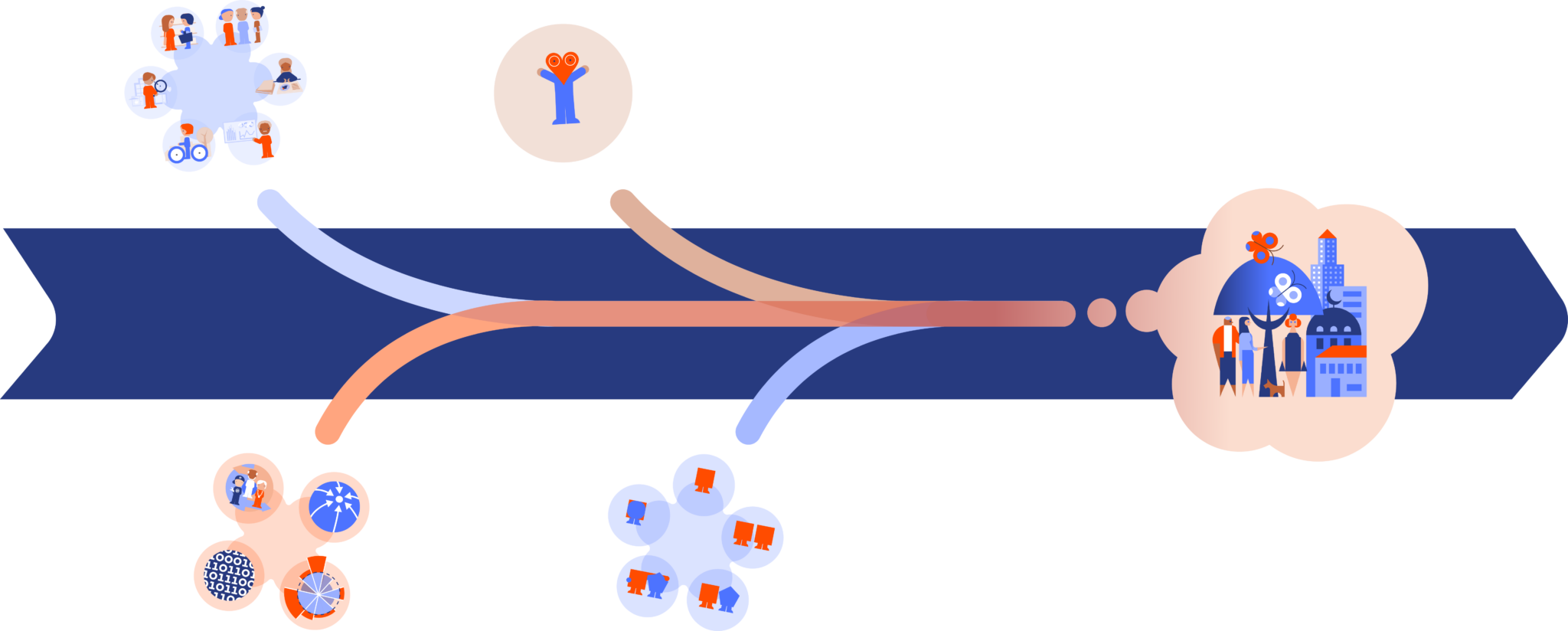At a certain point, the strategy seems to be finished. At that moment, it is no more and no less than a well-thought-out story. An implementation chapter should be added to complete the strategy.
Below are the key components of this chapter outlined very briefly.
>List of concrete projects
A strategy should also provide direction for the interventions you are planning. Which key projects do you select? Which guidelines must each project adhere to? What is the goal of the project? Who takes the lead, and where does the budget come from?
It is specifically within projects that the integration of disciplines in a systemic neighborhood approach comes to life. A strategy might set goals such as a) more housing is needed and b) the social network should be supported—but in a project like ‘Building 1,000 Homes’ it is essential to add that these homes must promote interaction among residents and create a diversity. I emphasize this because there is always a tendency for individual projects to lose the integration that was present in the strategy.
Also note, not all projects need to be ‘fixed’ in a top-down manner. They need a clear course, yes, but while working in the existing neighborhood there can also be room for development along the way. You might want to start with some placemaking for a certain project and along the way it might turn out that a local entrepeneur has a great idea that perfectly fits into the course, but wasn’t planned for.
>Planning
Although a strategy does not contain a detailed schedule, decisions about how planning will be approached are part of the strategy. The impact of prioritizing one project over another can be significant. If you need to build confidence amongst all stakeholders, you might chose a project with high visibilty and big impact in the neighborhood. And that choice is part of strategy.
>Monitoring of results
Monitoring is crucial as a feedback mechanism for the organization, to satisfy funders, and to keep all stakeholders motivated. It’s important to quantify goals in a way that reflects actual outcomes—or the lack thereof. The art is in quantifying (project) goals in a way that allows for meaningful monitoring. For example: visitor appreciation of a neighborhood can be measured through an annual survey and quantified by a rising satisfaction percentage. But appreciation could also be gauged from annual retail turnover monitoring—and the latter often resonates more.
>Organization and governance
Earlier, we mentioned the importance of a small coordinating team to steer the neighborhood transition and maintain strategic focus. This team should partly consist of independent individuals. However, it can be strengthened with some employees from existing stakeholder organizations to ensure continuity and shared responsibility.
A governance structure must be established in which key stakeholders have a seat. Depending on the anticipated financial flows, this could even take the form of a formalized partnership. The municipality is, in any case, an unavoidable stakeholder that rises above the others because it carries the public responsibility for the neighborhood. Since the municipality is publicly accountable through the executive board and city council, any governance structure must clearly relate to them.
>Budget and business case
It makes no sense to delay the renewal until the full budget is secured. However, the first five years must be funded to give the renewal a strong start. In those five years, projects will become more concrete, and a more detailed budget can be drawn up.
Once plans are sufficiently developed, a business case should be created to gain insight into additional financing needs. Subsidies will be required. Fundraising is a core task of the coordinating team. Also, all stakeholders wanting a seat at the table should contribute financially to confirm their engagement and responsibility.
>Communication
Communication is essential throughout the process. A narrative must be created about the “why” behind the neighborhood’s transition. Words should be chosen carefully: you want to create a sense of urgency, but without portraying the neighborhood as a lost cause or denying its existing strengths. Additionally, during the strategic development process, communication plays a key role in repeating milestone timelines like a mantra to keep everyone aligned. It’s also important to be transparent about the input received and how it has influenced the strategy in order to build trust.
Lastly, communication is crucial to energize all stakeholders and generate enthusiasm for the work ahead in the neighborhood.
>The process is 50% of the success
The substantive side of developing a neighborhood strategy is one thing. But in my experience, the process itself accounts for 50% of the strategy’s success. In the context of this article -which primarily focuses on content- I’ll limit myself to a few notes on this other 50%.
The main reason for the significant role the process plays in the success of a strategy lies in the people and their collaboration. I will highlight two aspects: first, multiple specialists must contribute their expertise; second, in an existing neighborhood, there are many stakeholders who are, in some way, involved in the transition.
About the specialists:
Developing a neighborhood strategy is a transdisciplinary task, coordinated by one or two non-specialists. Everything comes together in a neighborhood, making integration not just desirable but inevitable. For example, shops may be present, but if they’re not the right ones, it could lead to excessive car use. A beautiful park might feel unsafe and remain unused. Or a sports facility could be nearby but hard to reach by public transport. Depending on the neighborhood’s challenges and qualities, you’ll want a team that might include: an urban planner, local economy specialist, social worker, healthcare expert, civil engineer, culture specialist, land-use economist, educational facilities planner, landscape architect, real estate developer, and housing market analyst.
Specialists involved must meet two criteria: they need to be able to think strategically (which is different from simply being good at their daily work), and they must be comfortable working outside their comfort zone. The latter is often necessary because their input is rarely applied directly but must be integrated into a transdisciplinary process. Something not everyone is comfortable with.
About the stakeholders:
There are, above all, many stakeholders. Because a neighborhood transition is never the work of a single party. The collaboration between stakeholders, given their differing interests and degrees of organization, is a delicate process.
A core coalition must be formed, and it’s crucial how this is done and whether the coalition can truly offer the necessary leadership. Primary members are those with a substantial stake in the overall well-being of the neighborhood and/or those who would be severely affected if the area deteriorates, or those whose primary responsibility it is to ensure quality in the neighborhood. The municipality and the residents are inevitably the primary stakeholders. Other parties with more specific interests can be included for their particular expertise, funding capacity, or influence.
This coalition always requires an independent coordination team to keep the collaboration running efficiently throughout the strategy and implementation phases, maintaining focus, energy, and integration.
The process of strategy creation itself must be simple and that’s quite a skill. A clear process architecture must be in place outlining: key milestones, who is involved when, who participates in which discussions, how and when decisions are made, who integrates everything, and when each phase is concluded. There are many people involved, and not everyone sees neighborhood renewal as their top priority at all times. Still, it’s important that people contribute at the right moments, acknowledge decisions taken, and incorporate them into their own plans. The process architecture must create momentum and maintain focus. From the start, it must be clear that the key stakeholders—especially decision-makers—are committed. In my experience, the independent coordination team is best positioned to lead the process.


